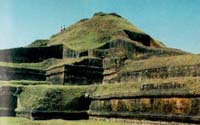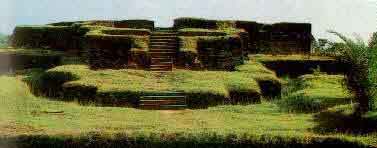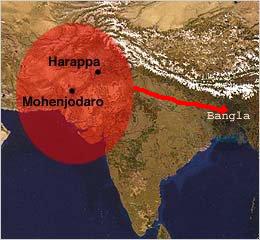Ancient History:
(NOTE: Bangla, Banga, Bengal will be used
interchangably as will Bengali, Bangalee and at times Bangla)
Contributions and Achievements by Ancient Bangla:
In ancient times, Bangla was a great nation with a distinct
culture and history. There were different dravidian and mongoloid people in Bengal before
the coming of the Aryans. They were probably united in the Prasoi and Gangaridai kingdoms
that existed there before the 3 century BC and probably until the Gupta Empire and were
probably ruled by Varman kings. From here Bengals went far and wide to spread their
culture.

Expansion and Spread of Culture:
- Tradition has it that Sri Lanka was colonized by a Bengali
(Bengal) Prince Vijayasingh who established the first political organization in that
island in 544 BC.
- Gadadhara, another Bengalee, founded a kingdom in the Madras state
in South India.
- Before the coming of the Tibeto-Chinese tribes into Burma and
Thailand, they were inhabited by the Mon-Khmer peoples. It was the Bengali-Kalinga people
that were the rulers of these empires. The Khmer empire of Cambodia was ruled by Indians
(Bengals) and later by the Barman (Varman) dynasty and was one of the greatest of the
Eastern Indian empires. They created the Angkor Wat. The Mon-Khmers were one of the original people of Bangla in ancient
times.
- Another Bengali empire in Laos/Vietnam called Champa had its
capital called Vijaya. Champa on the other hand was the name of the capital of Gaur
(ancient Bangla) where the Champas originated. Interestingly, Vijay(a) means victory in
Indian languages today and is a popular name. Was Sri Vijaya an ancient conqueror?
- It is possible that from Bengal, Indian culture spread to south
east Asia. It is even plausible since the sea outlet on the East was Bengal. This is
possible at least in Java if not the other Indian empires in the east. In Java was once a
great Indian empire that existed from before 135 AD and continued to dominate the region
past the 14th century AD. Nobody knows when or how Java became Indian. However, it can be
seen that the Javanese script from the sculptures of ancient times resemble that of
Proto-Bangla. (Modern Bangla was formulated later.) (Hasna Jasimuddin Moudud)
| Towards the end of the 10th century, Kambuj kings ruled
northeast Bangla. Were they the same as the Varman kings of Kamboj of Cambodia? NOVO |

Trade:
- Bengal is known as a great trading nation from the Mauryan era but
few know that Bangla was a great trading nation even before the Mauryans. It is also known
that Bengal was the greatest fabric producer in midieval times but Kautilya's Artha-Sastra
shows that Bengal was the greatest fabric centre from before the end of the fourth century
BC. This book was written at the end of the 4th century BC and it describes the fine
quality of silk and other crafts made in Pundra, Suvarnakudya and Vanga or Banga. (Hasna
Jasimuddin Moudud)
- When Greek historian Periplus talks about India in the first
century AD, apparently he speaks of Bangla. He says, "There is a river near it called
the Ganges (Ganga)" ... "On its bank is a market town which has the same name as
the river, Ganges (Ganga). Through this place are brought malabathrum and Gangetic
spikenard and pearls and muslins of the finest sorts, which are called Gangetic. It is
said that there are gold mines near these places, and there is a gold coin which is called
caltis. And just opposite this river there is an island in the ocean, the last part of the
inhabited world towards the east, under the rising sun itself, it is called Chryse (I wonder what island this is!); and it has
the best tortoise-shell of all the places on the Erythrean Sea" (Quote from Sudheer's
India's Contribution to the World's Culture).
Around 1400 BC, comes the first Indian
reference to hemp. later the Zend-Avesta writes about it and even Buddha is supposed to
have eaten hemp seeds to survive. North Indians called Hemp by the following names: Goni,
sana, shanapu, ganjika and Ganga and Banga and the Persians called it Bang... (The Encyclop�dia Britanica
Eleventh Edition. 1910-1911)
Bengals were called Ganga or
Gangaridoi (the empire) or Bang or Banga. Should we add hemp to the list of ancient Bengal
exports?
NOVO
|
Probable Bengal exports before the Gupta period:
- Gangetic spikenard and pearls
- Cotton facric
- Silk fabric
- Muslin fabric (the greatest fabric mankind ever produced but lost
during the colonial period)
- Hemp (hashis)
|

Learning:
- Bengal taught India elephant rearing. The oldest Indian treatise
on the training and diseases of elephants is the Hastyayur Veda, ascribed to Pala Kapya,
is a work compiled during the Sutra period (600-200BC). This was written by a man from
"where the Lauhitya (Brahmaputra, a river in Bangladesh) flows towards the sea".
(Hasna)
- Bengali alphabet was used by Buddhist Shrong Tsan who conquered
Northern India between 581-600 AD. (Hasna).
- Many of the venerated Buddhist scholars are Bangalee; Shilabhadra,
Chandragomin, Abhayakaragupta, Jetari, Shantiraksmit (from Sabhar, Dhaka, Bangladesh) and
Jnanasrimitra to mention a few. Bangla Buddhist monks also helped in the establishment of
the Nalanda, the greatest learning
centre of its time. ShilaBhadra (Bengal) was in charge of Nalanda (greatest learning
centre of its time) when Hiuen Tsang came there to study. There were several other ancient
universities scattered throughout Bengal and some of the ruins survive today.

Religion:
- Ancient Bengal was a centre of Shib (Shiva) worship and elements
of Shib worship existed there such as Yoga and transmigration of the soul. The north
Indians probably learned these concepts through their contact with the Bengals.
- Ancient Bangalees spread Mahayana Buddhism into the islands of
Indonesia.
- They went to Tibet and spread Buddhism there. Bangalee scholar
Santirakshit was one of the founders of the Buddhist monastic order in Tibet. The great
Buddhist sage Dipankara Srijnana also known as Atish Dipankar(Dhaka, Bangladesh) was
another great Buddhist from Bangla to have crossed the Himalayas to go to Tibet. He
reformed the monastic order in Tibet.
- Many branches of Buddhism and other local belief systems also
developed in Bengal. Vajrayana, Shajayana, Kalachakrayana, Tantrayana, Nathism, the Bauls,
and others originated in Bangla. Atish and ShilaBhadra converted Tibet and wrote both in
Sanskrit and Tibetan enriching the Tibetan litterature.

Seafaring:
Bengals were naturally inclined towards being sea faring people
living in a riverine land and on the coast. In old times the last name was given to a
person by the nature of one's profession, the Shaontals were called Majhis and there was a
kingdom of Malla in South West Bangla. Both Majhi and Malla mean sailor.
- Bengal had at least two seaports, one at Tamralipti in Soutwest
Bangla and another in the southeast. Mauryan and Gupta kings used Bengali port at
Tamralipti to trade. Some western historians often think (as in the American Library of
Congress) that the Bengal sea faring days began with the Guptas. However, Tamralipti
existed even during the Mauryan era and even when the Bengals (Dravirs) were being
Aryanized, they were considered ocean travellers. The earliest Buddhist literary reference
to Vanga (Bangla) in the Milinda-panho mentions Vanga as a maritime country where trading
ships came from various parts of the world. The Aryans themselves were landlubbers and
considered seafaring to be sacrilegious and were introduced to seafaring by the Bengals
during the Mauryan period.
- From the Tamralipti port Buddhists went to Sri Lanka to spread
Buddhism. And naturally there were famous Bengali seamen. One was a Bengali Captain
BuddhaGupta. Inscriptions from Malay in present day Malaysia talk about him as a great
Captain. On the west Kerala traded by sea and on the east Bengal traded.
- One of the first wars between the Aryans and the Bengals is
recorded and from here comes an interesting revealation. In Bhishma-parvan the Bengali
kings heroically face attacks from the Pandus or conquerors of Upper India. In the text it
is said that while some of the Bengal kings fought on elephants, others rode on ocean-bred steeds of the hue of the moon.
These were possibly warships. Was there a past history of Bengal that is forgotten?
| Sri Vijaya Empire once ruled much of East Asia from Java
(Job Dwip). The old writing of Java is similar to proto-Bangla, northeastern Indian
script. This empire was probably founded by Bengali Prince Vijay(a) Singh whose name was
borne by Sri Lanka (Singhala Dwip) in the olden days, as he had created the first Kingdom
there in 544 BC. Another Bengali empire in Laos/Vietnam called Champa had its
capital called Vijaya. Champa on the other hand was the name of the capital of Gaur
(ancient Bangla) where the Champas originated. Interestingly, Vijay(a) means victory in
Indian languages today. Greek historians talk of a nation that sold Muslin (Bengal is
the home of Muslin) and which extended far until the ocean on which was an island where
the sun rose. What island is this and what was the extent of ancient Bangla. NOVO |

Art and Architecture:
Not much architecture from the first century BC survives in
Bengal. Some ruins have been found from the first millennium AD. However, from ancient
references to cities like Gaur or Garh and Pundhra it seems Bengal was an urban nation.
One of the reasons why ruins of cities may not survived is the chaotic movement of the
rivers. The rivers over long periods of time shift and devour whatever is on its banks. It
may also be that the regular floods have covered the ruins deep in the ground. Moreover,
it is also possible that the first millennium cities such as Chandrahketugarh have been
built over older cities that were destroyed when Bengal was conquered .
- There are temples built in Burma (Myanmar or Brahmadesh)
that are in the model of Bangla temples.
- The architecture, sculpture and art of Cambodia and Indonesia were
inspired by that of Bangla. (Hasna Jasimuddin Moudud) These also show that
these empires might have been created by Bengali migrants just as Champa.
- The Pal art of Bangla also influenced the Nepalese, Javanese and Tibetan paintings, as well
as the Tang Art of China.
- According to Pag Sham Jon Zang, a book from Tibet, in the
eleventh century, Bengal occupied first place in the field of art. Tibetan opera or old
drama combines singing and dancing, which immediately reminds one of the Carya Nryta and
Carya singing which is still found in Nepal and Bhutan today. Dance movements in Tibetan
opera correspond with lyrics and melodies much as in the Carya Nrytas or dance. Some
movements, such as bowing with the hands clasped and scriptures. (Hasna)

Parts of Bangla was taken by the Mauryan Empire in the third
century BC and then it was conquered by the Guptas in the 4th century AD. Bangla was
aryanized after being incorporated into the Gupta empire and served as their maritime
outlet for both the Mauryan and Guptas. But soon Bengals achieved independence again and
contributed to the world as the great Pal Empire. Bangla continued to be a major sea
trader until recently.
| Hasna Jashimuddin Moudud says it would be interesting to compare
the cultural developments of the Champa and Bengals given the same origin and indeed it
would be so. |
However, doom was around the corner. An invasion
on the west by Arabs and Turks was slowly advancing towards Bangla to again occupy her.
Bangla would be ruled by foreigners once again for the next millennium. |
A Brief Time Line Of India
Click here to visit the cities of Bangla
- Possible ancient migration
- Principal regions of Ancient Bangla

- Pal Empire

Spread of Buddhism I

Spread of Buddhism II

Spread of Buddhism III

Spread of Buddhism IV
![[Paharpur]](http://www.virtualbangladesh.com/images/scenes/paharpur.gif)
Virtual Bangladesh : Rajshahi Tour

Oops! The map is wrong!

Paharpur

Moinamoti

Nalanda
(Bihar, India. Reached great heights during the Pal Empire.) |










![[Paharpur]](http://www.virtualbangladesh.com/images/scenes/paharpur.gif)



